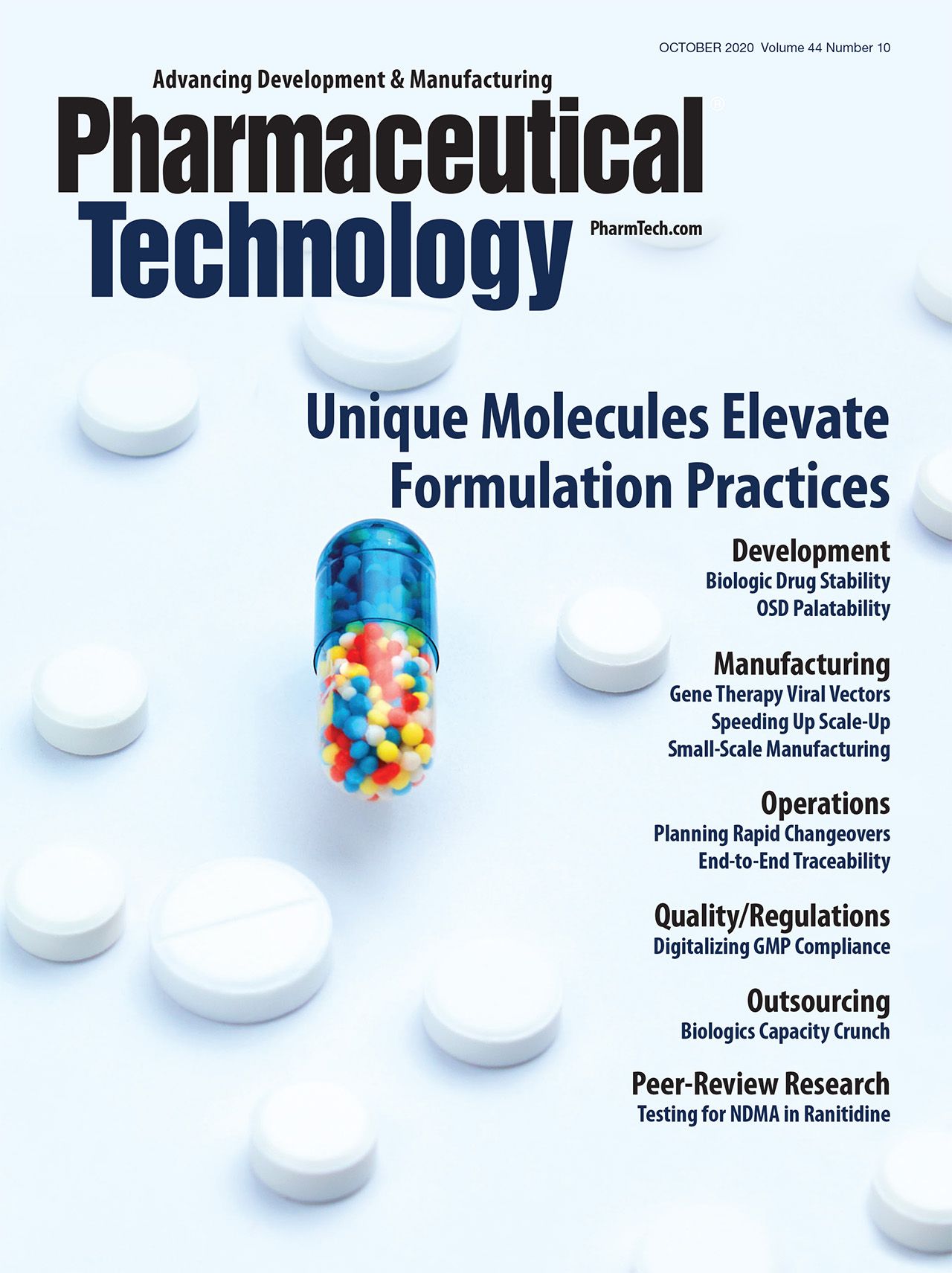News
Article
Pharmaceutical Technology
Unique Molecules Push Formulation Boundaries
Author(s):
More complex and challenging compounds require a more tailored approach to formulation strategies.
EVGENIY - STOCK.ADOBE.COM

Increasingly challenging and complex molecules entering the development pipeline are changing the way formulation development is approached. Furthermore, time and cost are considered to be at a premium, and demand for products to be commercially viable in the shortest time possible within a limited budget is ever more apparent.
According to market research, formulation is a key opportunity in drug development as formulation issues or challenges can readily lead to project failure or significant delays (1). “New molecule formats and extreme concentrations demand tailored formulation strategies instead of platform approaches now,” explains Andrea Hawe, co-founder and chief scientific officer of Coriolis Pharma.
Challenging compounds, enabling technologies
“The biggest trends that have been observed in formulation strategies over the past few years are that pharma companies are more open to complex technologies to address pipeline issues,” notes Jim Jingjun Huang, founder and CEO, Ascendia Pharmaceuticals. “Additionally, the increasing application of enabling technologies for use in challenging compounds, such as BCS [Biopharmaceutics Classification System] II and IV, is trending.”
This latter point, on challenging compounds, is of utmost importance for Sanjay Konagurthu, senior director, science and innovation, Pharma Services, Thermo Fisher Scientific. “Small molecules are still the largest segment of drug development in the industry. Oral and injectables dominate the pharmaceutical pipelines,” he adds. “In terms of oral drug delivery, it is currently estimated that 70–90% of small molecules in the pipelines have solubility and bioavailability challenges. This number has doubled compared to over 10 years ago.”
As a result of these solubility and bioavailability difficulties, conventional formulation approaches do not necessarily suffice, Konagurthu continues. “Depending on the physicochemical properties of the drug molecule, appropriate technologies and formulation strategies will have to be identified and evaluated,” he says.
For Hawe, the majority of trends that have been seen by industry in the area of formulation strategies has resulted from the increased diversity of biopharmaceutical molecules. “While monoclonal antibodies are still important, new formats—such as artificial peptides, fusion molecules, antibody fragments or bi/tri-specific antibodies—require new formulation concepts and novel analytical approaches,” she asserts. “This holds true also for advance therapy medicinal products (ATMPs), such as viral vectors for gene therapy or cell-based products, which are emerging rapidly, and where a lot of movement in the years to come is expected.”
Additionally, Hawe emphasizes that there is a trend toward high-concentration protein products, even beyond 200 mg/mL, of late, which has been sparked by the rising use of autoinjectors for subcutaneous self-administration and intravitreal administration. “For such products, formulation development needs to focus on viscosity and aggregation, next to chemical and conformational stability,” she says. “On the contrary, products that require ultra-low concentration formulations, for example bispecific T-cell engager, are also being developed. Here, surfaces adsorption and the development of suitable analytical methods are the challenges that formulation scientists must deal with.”
As a result of molecular and route-of-administration demands, project-specific approaches are now required, and for Hawe, these approaches should be based on existing, FDA-approved generally recognized as safe excipients, as there is a clear hesitancy by the pharma community to use novel excipients. “The analytical methods need to be developed so that they preferably measure the sample as-is,” she notes. “Thus, it is good to see a constantly increasing analytical portfolio including new submicron and micron particle characterization techniques and multi-attribute mass spectrometry methods.”
Considerations and practical tips
Both clinical and business objectives are important to consider when evaluating the most appropriate formulation strategy, according to Konagurthu. “Once the clinical and business objectives have been established, however, it is important to identify the quality target product profile (QTPP) of the drug and a phase-appropriate strategy that can accelerate drug development,” he says. “Special focus on performance, manufacturability, and stability is of course ultimately required for a drug to be commercially viable.”
The most appropriate formulation strategy will vary depending on each specific situation, emphasizes Hawe. By way of example, she specifies situations where there may be a small amount of material available or where the product is in preclinical trials, for which, she explains, it could be useful to develop a first reasonably stable, but not yet fully optimized formulation. “At later stages, when more material is available, but timelines are more aggressive, the strategy can include a parallel development of liquid and lyophilized formulations, for example,” she says.
When the project is in the early phase, the probability of success to test in first-in-human or first-in-patient is the most important consideration for evaluating formulation strategy, stresses Huang. “Once the project has successfully transitioned to the market formulation development (Phase IIb/III), then market acceptability or commercial aspect, scalability, intellectual property protection, and cost all become equally important,” he adds.
In terms of practical tips for developing a formulation strategy, Hawe highlights the importance of a reasonable chemistry, manufacturing, and controls (CMC) formulation development package early on in development. “Approaching clinical trials with a suboptimal formulation and facing stability issues or other challenges in later stages is, in the end, more time consuming and expensive,” she states.
For Huang, “following the science” when developing a formulation strategy is a requisite for a successful development program. “A rational design of tox and human formulations for the precious ingredients is critical to ensure a successful proof of concept in humans,” he says. “The key aspects for successful tox and early-phase formulation development consist of preformulation of the drug candidate, biopharmaceutical evaluation, analytical method development, formulation development, and [current good manufacturing practice] CGMP manufacturing for clinical trials.”
“Each drug molecule is unique, and it is critical to understand the physicochemical properties of the API and interactions with various excipients that are used in formulations,” asserts Konagurthu. “Also, excipients are not always inert and an understanding of how they might impact physiological targets should be considered. Building expertise and internal knowledge databases can be used to build predictive formulation tools.”
Hurdles and common mistakes
A major hurdle in developing the best formulation strategy, in Hawe’s opinion, is the compromise between being as fast as possible to the clinic and performing sufficient studies so that a high quality and stable product is developed. “Oftentimes, customers approach partner companies too late or with unrealistic timelines for full-scale formulation development but we then aim to find a satisfying middle ground,” she says.
Time and cost are also considered to be major issues for Huang, who comments that it is common for contract development and manufacturing organizations (CDMOs) to be expected to provide proof-of-concept for a customer’s compound from preclinical to in-human trials as quickly as possible and for a limited budget. “Therefore, it is important to come up with very efficient formulation strategies to meet these demands,” he adds. “In some cases, for very challenging compounds, it is possible to encounter a choice between developing the best formulation and being able to meet the budget and time demands.”
Moreover, there are hurdles to overcome in terms of the characteristics of drug molecules. “Some drug molecules can be very labile and, as a result, can provide significant chemical and physical stability challenges to the formulator,” continues Konagurthu. “Constraints on dose, drug loading in the dosage form, size, and weight can also present challenges.”
However, oftentimes companies do not allocate sufficient time and resources to developing an optimal formulation strategy for challenging compounds, stresses Huang. “The main goal for early-phase development is to test the compound’s safety and efficacy for the intended therapeutic indications in animal and humans,” he says. “Tremendous efforts need to be placed in improving the pharmacokinetic properties of compounds and ensuring bioavailability in animal models and human Phase I and II studies. A desired compound’s systemic exposure in testing subjects is prerequisite to meet the goals of early development. Otherwise, the drug program could be at a higher risk of costly failure in first-in-human and at later stages of development.”
Konagurthu also emphasizes that significant delays in timelines and overuse of critical resources can result when companies employ an empirical trial-and-error approach toward formulation, process development, and scale-up. “Lack of a thorough understanding of the in-vitro and in-vivo performance, process design space, and stability can lead to delays and program re-starts,” he explains. “Having an in-depth understanding of performance, manufacturability, and stability is important at all stages of product development and eventual commercial launch.”
In Hawe’s experience, there are three common mistakes that are made when developing a formulation strategy. “First, using excipients that are not FDA-approved and are not available in the required pharmaceutical quality. This can easily be omitted but happens surprisingly often,” she says. “Second, not considering the target product profile (TPP) and the requirement for a later manufacturing when starting formulation development. Third, skipping certain analytical methods and with it being blind for certain instabilities. Sometimes orthogonal approaches might seem like an overinvestment, but each technology has its blind spots and we need orthogonality to compensate for that.”
Technological advancements and trends
Although there may not be a single, magical technology that can make formulation development both quick and easy, Hawe notes that there are many small improvements that, in combination, can facilitate the process. “The application of artificial intelligence (AI) and improved statistical methods, for example, may reduce the number of experiments; better method automation/throughput and lower sample consumption will deliver more insights in less time or with less material; and advanced scientific understanding will improve decision making and reduce failures,” she says.
Technologies that enhance the solubility and permeability of drug candidates are important in the facilitation of formulation design for Huang. Optimization of solubility and bioavailability is achievable through using suitable delivery systems by screening a set of technology platforms that address different compound challenges in hydrophilicity, lipophilicity, permeability, and melting point, he explains.
“The use of predictive models can provide insights into formulation and technology selection based on the API’s physicochemical properties,” Konagurthu adds. “Use of a comprehensive material property database facilitates the development of predictive models that serve to guide formulation development. Advanced techniques such as compaction simulation can guide a rational, material-sparing formulation strategy.”
Additionally, when using predictive models, such as thermodynamics, discrete element method, or computational fluid dynamics for process development, it is possible to gain valuable insights into formulation design, Konagurthu continues. “Accelerated stability assessment programs can rapidly guide excipient selection in formulations and packaging design,” he says. “Use of physiologically based pharmacokinetic models to understand in-vivo performance can also aid in guiding formulation strategies (e.g., modified/controlled release).”
Moreover, Hawe believes that predictive methods, along with prior-art experience, will become ever more important for formulation development. “New and better predictive indicators, for example, for protein stability as well as base formulation development, will lay the foundation of future formulation strategies,” she states. “On top of that, data science in combination with AI will allow the required experiment to be narrowed down and to focus on the formulation corridor. While the development strategy will still be tailored to the specific product and situation, I expect development programs to become more efficient.”
An emerging trend that has the potential to help companies with the increasing pressures on quality, pricing, and productivity, is in the form of continuous manufacturing, remarks Konagurthu. “Continuous manufacturing can deliver higher quality oral solid-dose products, with greater flexibility and a reduced total cost of supply,” he says. “Formulation strategies for continuous manufacturing will require adopting a materials science-based approach.”
Benefits of partnerships
Outsourcing partners should play a crucial and integral role in formulation strategy, notes Huang. A partner can provide expertise in CMC, technology, and regulatory affairs, or can act as a traditional pharmaceutical R&D department for the sponsor company, he states.
“A knowledgeable CDMO partner can help bolster product knowledge throughout all phases of a program lifecycle,” adds Konagurthu. “A CDMO with hands-on experience with a host of compounds and formulations can help build quality-by-design (QbD) into a product, as they will have deep knowledge to draw on for addressing problems that arise during development.”
Application of QbD principles early on in development, along with predictive models and risk assessment tools, are useful in mapping the design space for the formulation and processes, and ultimately, developing commercially viable formulations and processes, Konagurthu notes.
“The biggest benefit of having a specialist partner for formulation development is the experience and scientific knowledge that can be applied to the benefit of our clients,” Hawe summarizes. “However, formulation development is not just a strategy. Specialized analytics, dedicated methods, and excellent scientists to run them are all required and are assets an experienced partner can provide.”
Reference
- Rentschler Biopharma, “2018 Survey: Formulation in the Drug Development Process,” Industry Insights, rentschler-biopharma.com, Nov. 6, 2018.
About the Author
Felicity Thomas is the European editor for Pharmaceutical Technology Group.
Article Details
Pharmaceutical Technology
Vol. 44, No. 10
October 2020
Pages: 16–19
Citation
When referring to this article, please cite it as F. Thomas, “Unique Molecules Push Formulation Boundaries,” Pharmaceutical Technology 44 (10) 2020.
Newsletter
Get the essential updates shaping the future of pharma manufacturing and compliance—subscribe today to Pharmaceutical Technology and never miss a breakthrough.





